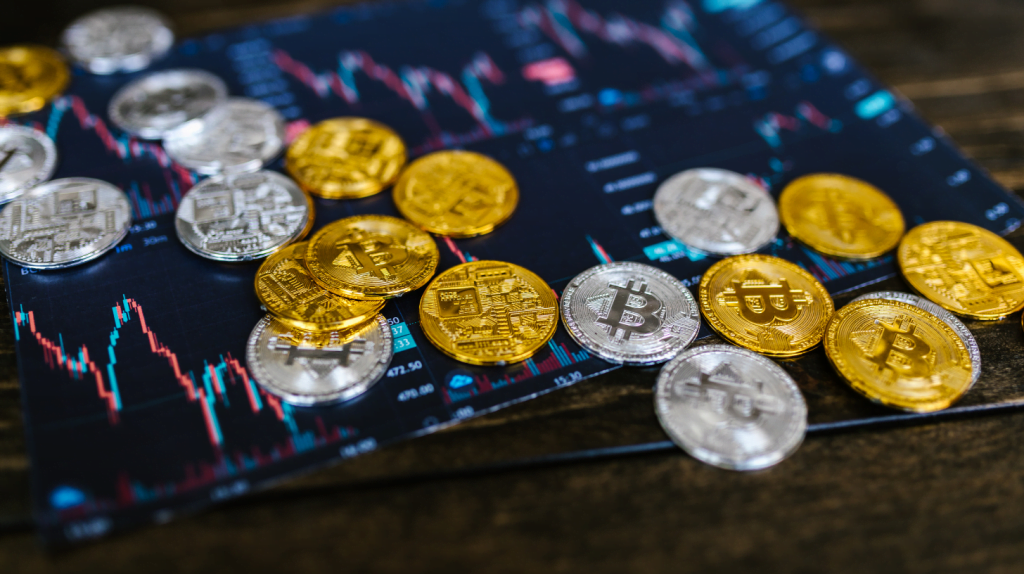Introduction
Cryptocurrency has emerged as a popular investment option, but just how much money has been invested in this innovative form of currency?
The investment landscape of cryptocurrency has showcased a vibrant and dynamic scenario. As of August 2023, the worldwide market capitalization of cryptocurrencies stood at an impressive $1.09 trillion, mirroring the burgeoning interest and financial influx in this digital frontier. This statistic not only underscores the significant financial commitment infused into cryptocurrencies but also reflects the burgeoning confidence among investors, hinting at an expansive trajectory for the crypto realm
Key Takeaways:
- The total investment in cryptocurrency, was estimated at $1.09 trillion as of August 2023
- Companies with tangential exposure to digital assets are vulnerable to crypto market volatility.
- Funds exposed to cryptocurrencies tend to have lower returns compared to broader equity markets.
- No observable correlation has been found between tangential digital asset exposure and U.S. core CPI inflation.
The Scope of Cryptocurrency Investments
From Bitcoin to Ethereum and a myriad of other digital currencies, the cryptocurrency market has seen tremendous growth over the years, attracting investors from around the world. With the advent of blockchain technology, cryptocurrencies have gained popularity due to their decentralized nature and potential for high returns.

Valuation of cryptocurrencies can be complex, as different cryptocurrencies have various supply models. Some cryptocurrencies, like Bitcoin, have a limited supply, while others have more flexible supply models. This uniqueness adds to the allure and volatility of the digital currency market. Changes to supply models can also impact the value of cryptocurrencies, making accurate valuation challenging.
The market capitalization of cryptocurrencies has reached staggering levels, reflecting the immense investments made in this asset class. As per recent reports, the total market capitalization is well into the trillions of dollars. This demonstrates the growing confidence in digital currencies and the immense potential they hold.
| # | Cryptocurrency | Market Capitalization |
|---|---|---|
| 1 | Bitcoin (BTC) | $525.59 Billion |
| 2 | Ethereum (ETH) | $201.42 Billion |
| 3 | Tether (USDT) | $83.24 Billion |
| 4 | BNB (BNB) | $33.06 Billion |
| 5 | XRP (XRP) | $27.57 Billion |
| 6 | USDC (USDC) | $25.04 Billion |
| 7 | Lido Staked Ether (STETH) | $14.72 Billion |
| 8 | Cardano (ADA) | $8.80 Billion |
| 9 | Dogecoin (DOGE) | $8.74 Billion |
| 10 | Solana (SOL) | $8.38 Billion |
Investors need to be aware of the risks and uncertainties associated with investing in cryptocurrency. Market volatility is one such risk, as prices can fluctuate dramatically within short periods. Additionally, publicly listed companies and investment funds with tangential exposure to digital assets can be vulnerable to the unpredictability of the crypto markets.
While the performance of intentionally and unintentionally exposed funds has shown similarities to that of Bitcoin, with lower returns compared to broader equity markets, there is no observable correlation between tangential digital asset exposure and U.S. core CPI inflation. This suggests that cryptocurrency investments may have their own unique dynamics and may not directly align with traditional economic indicators.
Understanding the Risks and Challenges
While the allure of cryptocurrency investment is undeniable, it is important to be aware of the risks and challenges that come with this highly speculative asset class. As with any investment, there are potential pitfalls that investors need to consider before diving into the world of digital currencies.
One of the major risks associated with cryptocurrency is the prevalence of fraud. Recent cases, such as the Department of Justice’s seizure of virtual currency worth $112 million linked to cryptocurrency investment scams, highlight the extent of fraudulent activities in this space. Fraudsters often employ elaborate storylines, deceiving victims into believing they are in a close personal relationship before enticing them to invest in fraudulent cryptocurrency trading platforms. These scams have resulted in billions of dollars in losses for victims, emphasizing the need for caution and due diligence when considering cryptocurrency investments.

Another challenge is the inherent market volatility of cryptocurrencies. The value of digital currencies can fluctuate dramatically in short periods, leading to significant gains or losses for investors. The complex supply models used by various cryptocurrencies add to the uncertainties. Changes to these models, such as alterations in the inflation rate or the total supply of tokens, can further impact the value of the digital assets. It is crucial for investors to understand and carefully monitor these factors to make informed investment decisions.
Furthermore, exposure to the crypto markets can present risks for both companies and individual investors. Publicly listed companies with tangential exposure to digital assets may face increased vulnerability to the unpredictability of the crypto markets. Additionally, investors who intentionally or unintentionally become exposed to cryptocurrency through funds or other investment vehicles may experience similar performance to that of bitcoin, with lower returns compared to broader equity markets. However, it is worth noting that research suggests there is no observable correlation between tangential digital asset exposure and U.S. core CPI inflation.
| Risks | Challenges | Fraud |
|---|---|---|
| Cryptocurrency investment scams | Market volatility | Exposure to unpredictable fluctuations |
Implications for Companies and Investors
As cryptocurrency investments continue to gain momentum, companies and investors are grappling with the potential implications of this new asset class on their financial portfolios.
One of the key implications is the exposure that companies and investors have to the volatile cryptocurrency markets. With the rapid fluctuations in cryptocurrency prices, publicly listed companies and investment funds with tangential exposure to digital assets may find themselves vulnerable to market unpredictability. This means that their financial performance could be heavily influenced by the performance of the crypto markets, which can be both a blessing and a curse.

Research suggests that the performance of intentionally and unintentionally exposed funds has been similar to that of bitcoin, with lower returns compared to broader equity markets. This indicates that while cryptocurrency investments have the potential for significant gains, they also carry a higher degree of risk. Companies and investors must carefully consider their risk tolerance and diversify their portfolios to mitigate potential losses.
Another important implication is the lack of observable correlation between tangential digital asset exposure and U.S. core CPI inflation. This means that while cryptocurrency investments may provide diversification benefits, they may not necessarily act as a hedge against inflation. Investors should be cautious about relying solely on cryptocurrencies to protect their portfolios from inflationary pressures.
| Implications for Companies and Investors | |
|---|---|
| Exposure to volatile cryptocurrency markets | Companies and investors may experience financial performance influenced by market unpredictability. |
| Potential gains and higher risk | Performance of exposed funds has been similar to bitcoin, with lower returns compared to broader equity markets. |
| Limited hedge against inflation | Observable correlation between digital asset exposure and U.S. core CPI inflation is lacking. |
Conclusion
The future of cryptocurrency investments holds both exciting possibilities and inherent risks, as the world continues to navigate the evolving landscape of digital currencies. With the amount of money invested in cryptocurrency steadily growing, it is clear that this asset class has gained significant attention and traction from investors.
However, as highlighted by recent cases of fraud and scams, it is crucial for investors to exercise caution and due diligence when entering the cryptocurrency market. The Department of Justice’s seizure of virtual currency worth $112 million linked to investment scams serves as a sober reminder of the risks associated with this digital frontier.
Valuing cryptocurrencies can be complex, and the different supply models used by various cryptocurrencies introduce additional uncertainties. Changes to these supply models can have significant implications for the future value and performance of the digital assets. As the market continues to mature, it is essential for investors to stay informed and adapt to these evolving dynamics.
Moreover, the inherent volatility of cryptocurrency markets poses challenges for both companies and investors. Tangential exposure to digital assets can expose companies to unpredictable fluctuations, impacting their performance and financial stability. Investors with exposure to cryptocurrencies may experience similar returns to bitcoin, but lower returns compared to broader equity markets.
While the future of cryptocurrency investments is promising, it is crucial to approach this asset class with a clear understanding of the risks involved. By staying informed, exercising caution, and adapting to market dynamics, investors can navigate this evolving landscape and seize the exciting possibilities that digital currencies offer.
FAQ
Q: How much money has been invested in cryptocurrency?
A: The exact amount of money invested in cryptocurrency is difficult to determine, but it is estimated to be in the billions of dollars.
Q: What types of cryptocurrencies are available for investment?
A: There are thousands of different cryptocurrencies available for investment, with Bitcoin being the most well-known and widely used.
Q: What are the risks of investing in cryptocurrency?
A: Investing in cryptocurrency carries risks such as fraud schemes, market volatility, and potential exposure to unpredictable market fluctuations.
Q: How do cryptocurrency investments affect companies and investors?
A: Companies and investors with exposure to cryptocurrency may be affected by the performance of digital assets, but there is no observable correlation between tangential digital asset exposure and U.S. core CPI inflation.
Q: What is the future of cryptocurrency investments?
A: The future of cryptocurrency investments is uncertain, but they continue to attract significant attention and investment as the technology develops and matures.
Source Links
- https://www.sygnum.com/research/research-reports/decoding-cryptocurrency-valuation-uncovering-bitcoins-true-value-through-methodical-analysis-2/
- https://www.morningstar.com/funds/uncovering-hidden-crypto-exposures-your-investment-portfolio
- https://www.justice.gov/usao-cdca/pr/justice-dept-seizes-over-112m-funds-linked-cryptocurrency-investment-schemes-over-half
